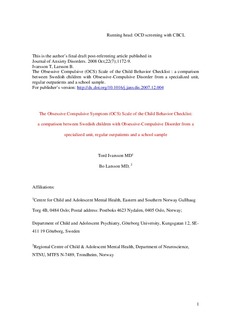The Obsessive-Compulsive Symptom (OCS) scale of the Child Behavior Checklist: A comparison between Swedish children with Obsessive-Compulsive Disorder from a specialized unit, regular outpatients and a school sample
Journal article
Permanent lenke
http://hdl.handle.net/11250/2386759Utgivelsesdato
2008Metadata
Vis full innførselSamlinger
Sammendrag
To evaluate the discriminative power of various items as reported by parents in the OCS-scale extracted from the Child Behavior Checklist (CBCL) problem scale and to compare findings with outcomes of previous validation studies.
Children referred to a specialized child psychiatric Obsessive-Compulsive Disorder (OCD) clinic (OCD group) (n = 185) receiving a formal OCD diagnosis according to DSM IV criteria based on interviews with the Children's Yale-Brown Obsessive-Compulsive Scale (CY-BOCS) were compared to a sample recruited from regular child and adolescent psychiatric outpatient clinics (CPO group) (n = 177). Both samples were compared to a normative school sample (SS group) and all three groups were matched for age and gender.
Thirty seven CBCL items, mostly representing core internalizing symptoms and parts of the thought problem scale as well as physical and sleep problems, were first identified. Ten of these items (including all discriminative items in previous validation studies) could distinguish children with OCD from CPO patients. In a subsequent analysis, the results of a logistic regression showed that four CBCL items, “Obsessions,” “Fearful and Anxious,” “Compulsions,” and “Worries” remained significant predictors. These four OCS items and previously used CBCL OCS-scales were further examined by means of ROC-analysis showing that the “Obsessions” and “Compulsions” CBCL items were the strongest predictors.
These two CBCL items performed well as screens for OCS symptoms in children and adolescents and the addition of similar CBCL items did not further increase sensitivity or specificity. It is suggested that parental responses on these two items could preferably be used as screen for OCD in children and adolescents in regular child psychiatric clinics.
Beskrivelse
-
